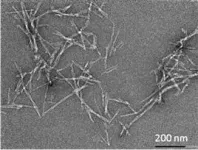Understanding the growth of disease-causing protein fibres
UK researchers from the University of Bath and the ISIS Neutron and Muon Source have developed a method to directly measure the growth rate of 'amyloid' fibrils linked to Parkinson's, Alzheimer's and other diseases
2021-04-15
(Press-News.org) Amyloid fibrils are deposits of proteins in the body that join together to form microscopic fibres. Their formation has been linked to many serious human diseases including Alzheimer's, Parkinson's and Type 2 diabetes.
Until today, scientists have been unable to reliably measure the speed of fibril growth, as there have been no tools that could directly measure growth rate in solution. However, researchers from the UK's University of Bath and the ISIS Neutron and Muon Source have now invented a technique that does just that. Results from their study are published in RSC Chemical Biology.
"This is an important breakthrough, as information on fibre growth is key to understanding the diseases associated with amyloid fibrils," said Dr Adam Squires from the Department of Chemistry at Bath, and study co-author. "Knowing what makes these fibres grow faster or slower, or whether they break and what makes them break - in other words, understanding these fibres at a molecular level - could eventually have implications for researchers looking for treatments for these serious diseases."
He added: "This new technique will also help scientists investigating non-medical roles of protein folding and self-assembly - for instance, in biological processes such as inheritance in yeast, or for research into new nanomaterials."
WHY GROWTH RATE IS BEST MEASURED IN SOLUTION
Most experimental techniques for measuring fibril growth in solution only measure how fast proteins transform into fibril material overall, not how long each fibril is or how fast it is growing. Other techniques measure just one fibril attached to a surface such as glass or mica. These conditions do not reflect the real biological process, which occurs in solution.
Researchers for the new study used Small Angle Neutron Scattering (SANS) to study the growth rate and length of amyloid fibrils as they assembled in solution. By using the unique ways neutrons interact with hydrogen and its isotope deuterium, the researchers were able to use 'contrast matching' to make all of the fibrils invisible to neutrons apart from the growing tips. Using the SANS2D instrument at the ISIS neutron facility, they watched these tips become longer in real time. This gave a direct measurement of the growth rate, which had never been done before.
The results of growth rate from this study align with values estimated from other methods, indicating that SANS is a suitable tool for measuring amyloid fibril growth.
The technique also allowed the researchers to measure the number of fibril ends present in a given sample. This information told them how many separate fibres were growing, and the length of each one. The fragility of fibrils from different proteins, and how often they break into shorter fragments exposing more growing ends, is a key part of the puzzle to understand fibril disease propagation.
Lead researcher Dr Ben Eves carried out the experiments at Bath as part of his ISIS Facility Development studentship.
"I'm thrilled with the success of this method," he said. "Developing this technique was a truly amazing experience. Understanding the growth of amyloid fibrils is fundamental to understanding their pathogenic, biological and technological properties."
He added: "In future, I believe this technique could be used to investigate the effect of different factors that affect the growth rate of amyloid fibrils, as well as to measure the impact of therapeutic molecules (the building blocks of medicines) designed to slow down or prevent the growth of amyloid fibrils."
INFORMATION:
[Attachments] See images for this press release:

ELSE PRESS RELEASES FROM THIS DATE:
2021-04-15
In a newly released study, researchers found that remote and virtual care models can negatively impact small physician offices. Three researchers from END ...
2021-04-15
To better understand the psychological and physical impact caused by the profound consequences of the COVID-19 pandemic - and also inform priorities for interventions and policy changes to address the mental health consequences of the pandemic -- researchers from the Center for the Developing Brain at the Child Mind Institute developed and deployed the CoRonavIruS health and Impact Survey (CRISIS). This questionnaire covered key topics relating to mental distress and resilience during the pandemic. According to a newly-published manuscript of the findings, perceived risk of COVID-19, prior mental health status, and lifestyle changes were key predictors of mental health during the pandemic in adults and children surveyed in the U.S. and U.K.
In the study, supported by the Morgan Stanley ...
2021-04-15
URBANA, Ill. - Agricultural producers deal firsthand with changing weather conditions, and extreme events such as drought or flooding can impact their productivity and profit. Climate change models project such events will occur more often in the future. But studies of the economic consequences of weather and climate on agriculture typically focus on local impacts only.
A new study from the University of Illinois looks at how changes in weather - including extreme events - may decrease crop profit in one state while increasing profits in other states. The secret ingredient: U.S. interstate trade. It is expected to mitigate ...
2021-04-15
The field of ancient DNA has revealed important aspects of our evolutionary past, including our relationships with our distant cousins, Denisovans and Neandertals. These studies have relied on DNA from bones and teeth, which store DNA and protect it from the environment. But such skeletal remains are exceedingly rare, leaving large parts of human history inaccessible to genetic analysis.
To fill these gaps, researchers at the Max Planck Institute for Evolutionary Anthropology developed new methods for enriching and analyzing human nuclear DNA from sediments, which are abundant at almost every archaeological site. Until now, only ...
2021-04-15
The widespread proliferation of the internet and information and communication technologies (ICT) has drawn people into urban centres, according to new research.
Despite being able to access data at the drop of a hat or speak face-to-face to people on the other side of the world, the evolution of technological capabilities hasn't led to an exodus from cities. In fact experts at the University of Bristol have found quite the opposite; that the increased adoption of ICT has resulted in national urban systems - cities within a country - that are characterised by higher population concentrations. ...
2021-04-15
A new generation of miniature recording probes can track the same neurons inside tiny mouse brains over weeks -- and even months.
The new tools build on the success of the original Neuropixels probes released in 2017 and currently used in more than 400 labs. Neuropixels 2.0 are much smaller -- about a third the size of their predecessors. They're designed to record the electrical activity from more individual neurons and have the unique ability to track this activity over extended time periods. That makes them especially useful for studying long-term phenomena like learning and memory in small animals such as mice, says Tim Harris, a senior fellow at HHMI's Janelia Research Campus who led the project. Harris and his colleagues describe the advance in a paper published online ...
2021-04-15
Irvine, Calif., -- By analyzing gains and losses in the genes of phytoplankton samples collected in all major ocean regions, researchers at the University of California, Irvine have created the most nuanced and high-resolution map yet to show where these photosynthetic organisms either thrive or are forced to adapt to limited quantities of key nutrients, nitrogen, phosphorus and iron.
As part of the new Bio-GO-SHIP initiative, the UCI scientists made eight deployments on six different research vessels, spending 228 days at sea in the Atlantic, Pacific and Indian oceans. They generated nearly 1,000 ocean metagenomes from 930 locations around the globe, with an average distance between collection points at 26.5 kilometers (about 16.5 miles). ...
2021-04-15
University of California, Berkeley, chemists have discovered a way to simplify the removal of toxic metals. like mercury and boron. during desalination to produce clean water, while at the same time potentially capturing valuable metals, such as gold.
Desalination -- the removal of salt -- is only one step in the process of producing drinkable water, or water for agriculture or industry, from ocean or waste water. Either before or after the removal of salt, the water often has to be treated to remove boron, which is toxic to plants, and heavy metals like arsenic and mercury, which are toxic to humans. Often, the process leaves ...
2021-04-15
Being constantly hungry, no matter how much you eat - that's the daily struggle of people with genetic defects in the brain's appetite controls, and it often ends in severe obesity. In a study published in Science on April 15, researchers at the Weizmann Institute of Science, together with colleagues from the Queen Mary University of London and the Hebrew University of Jerusalem, have revealed the mechanism of action of the master switch for hunger in the brain: the melanocortin receptor 4, or MC4 receptor for short. They have also clarified how this switch is activated by setmelanotide (Imcivree), ...
2021-04-15
Hafnium-based thin films, with a thickness of only a few nanometres, show an unconventional form of ferroelectricity. This allows the construction of nanometre-sized memories or logic devices. However, it was not clear how ferroelectricity could occur at this scale. A study that was led by scientists from the University of Groningen showed how atoms move in a hafnium-based capacitor: migrating oxygen atoms (or vacancies) are responsible for the observed switching and storage of charge. The results, which were published online by the journal Science on 15 April, point the way to new ferroelectric materials.
Ferroelectric ...
LAST 30 PRESS RELEASES:
[Press-News.org] Understanding the growth of disease-causing protein fibres
UK researchers from the University of Bath and the ISIS Neutron and Muon Source have developed a method to directly measure the growth rate of 'amyloid' fibrils linked to Parkinson's, Alzheimer's and other diseases




